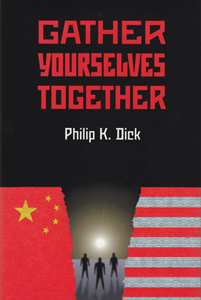“Gather Yourselves Together” (written about 1950, published in 1994) is a 373-page novel with no plot, and whether that’s a feature or a bug depends on the reader’s taste. But it’s certainly a fascinating entry in Philip K. Dick’s catalog from a historical perspective.
Most PKD scholars believe it’s the first novel he wrote, and it definitely feels that way. It’s all about middle-aged Verne, mid-20s Barbara and slightly younger Carl dancing around each other at a shuttered American metal works operation in China in 1950. They are guarding the property in the week before the now-in-power Communists arrive to take possession.
Alone together with their thoughts
The novel is all about these three people and their thoughts – and sometimes actions – about whether or not they want to be in a relationship: Verne toward Barbara, Barbara toward Verne, Carl toward Barbara, and Barbara toward Carl.

“Gather Yourselves Together” (1994)
Composition year: About 1950
Author: Philip K. Dick
Genre: Fiction, coming-of-age
Setting: 1950, China
Dick’s next-written novel, “Voices from the Street” (written about 1952, published in 2007), has more layers and themes, integrates everything better, and brings the action to the Bay Area, setting the template for all of his subsequent realist novels.
But oddly enough, “Gather Yourselves Together” might feature Dick’s very best work with conversational dialog. It feels like we’re reading a stage play about relationships and the male’s and female’s thoughts and outward expressions when they become (or think they might be becoming) attracted to a person.
It also calls to mind J.D. Salinger’s dialog-heavy works such as “Franny and Zooey” – which was written starting in 1955 and published as a book in 1961, so PKD was not influenced by that specific work. (“Voices from the Street,” meanwhile, calls to mind “Catcher in the Rye,” which does predate Dick’s book.)
Momentum despite lack of plot
Although there is no plot, “GYT” has momentum because PKD takes us into the trio’s progressing thoughts. Plus, flashbacks to their pasts open up the novel beyond what could be a claustrophobic setting of a few buildings amid a shut-down construction yard.
They are fairly common personality types, not the extreme sad sacks who would later become the author’s go-to protagonists. Verne is cynical and morose, Barbara doesn’t know what she wants from life and has a tendency to blame others, and Carl is a wide-eyed innocent wrapped up in books and big ideas about existence – but Barbara creeps into his consciousness.
All of their inner thoughts ring true, even Barbara’s, despite the admission from Verne (a stand-in of Dick’s to some degree) that it’s impossible to know what women are thinking. The book has something to say about the chain of behavior: Verne is to Barbara what Barbara becomes to Carl.
In decidedly clunky fashion, PKD works in some political thoughts through Carl, his closest stand-in. They’re the same age and have similar backgrounds. Carl was a socialist during his brief college stint, but now he is questioning that philosophy. In an epilogue, Carl asks a Chinese man about the use of force to achieve political ends; it seems Dick was troubled by this aspect of socialism when writing “GYT.”
Editors deserve credit
If a reader is generous, they could draw parallels to the various forces individual humans exert on other individual humans, as exemplified by the central trio. That might be a case of being too generous, even though the book’s title cleverly applies to both personal grounding and political collectivism. PKD doesn’t integrate characters with theme very well, and as noted, there isn’t a plot of any complexity. Had “GYT” gone through an editorial process, those issues might’ve been worked on.
Speaking of the editorial process, the fact that “GYT” and “Voices from the Street” were bulky manuscripts – more than 100 pages longer than what got published – is probably why it took so long for them to see the light of day. It’s a shame the book world doesn’t give credits for editors the way a film does.
Whoever edited “GYT” and “Voices” deserves praise for chipping away at Dick’s drafts and finding the novels within, while not being able to go through rewriting steps with the author. It would be nice if we could someday find out who edited these two novels and learn about what the process was like.
“GYT” is still padded and overlong compared to what would be an ideally tight novel. Sometimes a character will think the same thought a couple pages in a row; this reflects the way a troubled mind operates, but it can bog down the narrative flow.
Not for a newcomer, but fun for fans
This is not the first PKD book you’d want to recommend to a newcomer – unless they love stage plays or Salinger — even though it is his first-written novel. In addition to being thematically insubstantial, it’s not representative of PKD’s core themes or even his writing style.
On the other hand, it should be highly recommend to serious PKD fans for those very reasons. Verne, Barbara and Carl are strikingly real people in their speech, thoughts and actions. They lack the absurdist comedic traits – other than common human absurdities – found in many of PKD’s later characters. They live in a less cynical age (in both senses of “age”), yet have their eyes are wide open.
They haven’t absorbed as much as those later sad sacks. But “Gather Yourselves Together” shows that Dick clearly soaked up more about human nature (including his own) than most young adults.


